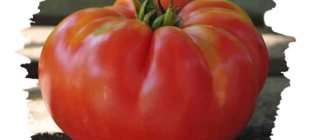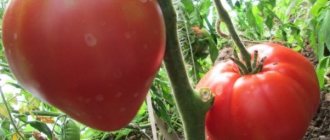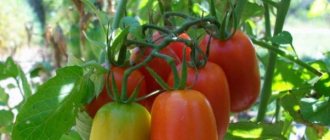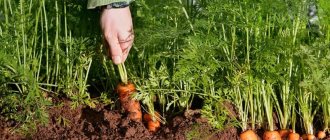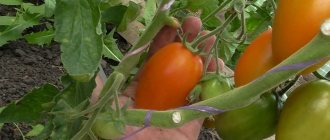Tomato Kumato is a black-fruited indeterminate variety without GMO content. Attracts the attention of gardeners due to the black color of the fruit and the increased content of nutrients. For example, it contains 2-3 times more vitamin C than yellow and red varieties. What is the reason for this composition of Kumato, how to grow and use it, we will understand further.
Tomato seeds "Kumato"
Tomato variety "Kumato" in section
Kumato tomato fruits are aphrodisiacs
Breeding history and distribution
The origin of this variety is quite ambiguous. According to the main version, its homeland is the Galapagos Islands, where the tomato grows in the wild. In its current form, it appeared on the European market thanks to the scientific work of Belgian breeders, who, without any genetic engineering, crossed wild tomatoes with “domesticated” varieties of tomatoes. The fruits are black in color due to the blackberry-based pigment they contain.
According to another popular version, concrete work on breeding this hybrid form was started almost 50 years ago by geneticist Luis Ortego. In the 1970s, a farmer was driving around his fields in the village of Agra (almeria coast, Spain) and noticed that the tomatoes in the last rows, where salty soil predominates and moisture is least, had a different color, but a more intense taste and bright aroma. Since then, Ortego decided to grow only such tomatoes, creating specific conditions for this, which was not difficult in the Mediterranean.
Subsequently, the Spanish company Syngenta received the right to breed black tomatoes. The bred tomato was named Olmeca F1, but in many countries it is more recognizable under the Kumato brand.
Today the variety is very popular in Europe, Turkey and Australia, but in the CIS countries it is not particularly widespread.
In Russia, the variety is not included in the State Register of Breeding Achievements, but can be grown throughout the country, especially in the southern regions.
Description of the variety
The Kumato tomato belongs to the mid-season varieties, closer to the late ones. The harvest can be harvested 100-120 days after the first shoots appear. How the bushes develop, how the fruits differ, besides the black color, we will consider separately.
Bushes
The external qualities of this plant are traditional and correspond to the category of tall varieties:
- Height . By type of growth, Kumato is indeterminate and reaches a height of 2-2.5 m. The tip of the shoot must be pinched until it reaches 2 m in order to provide favorable conditions for the development of fruits.
- Rhizome . Dense, grows wildly in all directions by more than 0.5 m and occupies an area with a diameter of up to 50 m. Its distribution occurs without depressions.
- Stem . It is persistent, bristly and liana-like (resembles a liana in appearance) with medium foliage. Continues to grow even during the fruiting period.
- Leaves . They are small in size, have a normal structure characteristic of most tomato varieties, have a wrinkled cellular surface and a dark green color. There are no pubescences.
- Articulation . It is simple and intermediate, that is, the first inflorescence is formed above the 8-9 leaf, and the subsequent ones - every 1-2 leaves.
- Brush . Up to 8 simple flower clusters can appear on one plant. Each of them produces 6-8 tomatoes.
Fruit
The fruits collected in clusters are distinguished by their exotic appearance and original taste:
- Color . Unripe fruits have a pale green tint, without spots or inclusions, uniform around the stalk. As they mature, the color begins to gradually darken, first turning into dark burgundy and then chocolate. Sometimes the color may be uneven and have thin green stripes.
- Shape and dimensions . The shape of the fruits can be either round or oval with a small number of ribs. Their sizes are average: diameter is about 5-7 cm, weight is on average 80-100 g. All ripe tomatoes look almost the same.
- Pulp. Meaty and dense, but tender. It has a rich dark red color, but sometimes greenish notes are visible. By the number of ribs, you can determine the number of seed chambers inside a ripe tomato. There are 2, 3 and less often 4. Thus, the seeds occupy a smaller part of the fruit and are evenly distributed throughout the chambers. The proportion of dry matter in tomatoes is more than 5%, which is significantly higher than that of ordinary red tomatoes.
The structure of the pulp is sugary-oily with thick walls and a high juice content.
- Taste . Black tomatoes have an original taste - sweet with light fruit and berry notes and complementary sourness. The aroma is bright and rich. It is noteworthy that the taste is preserved even after heat treatment.
- Application . Kumato is a dessert variety and is more intended for fresh consumption. The fruits can be served as slices or as part of various salads. Meanwhile, they can also be used to prepare soups and main courses. Some farmers also prefer to can tomatoes, which tolerate heat treatment well due to their high density.
The fruits are well stored and can easily be transported because they do not crack due to their thick skin.
You can see what black tomatoes look like in the following video:
Characteristics table
The main characteristics of the Kumato tomato can be found below:
| Parameter | Description |
| Basic qualities | Indeterminate, mid-season, dessert variety |
| Ripening period | 100-120 days after the appearance of the first shoots |
| Productivity | Stable and high. From one bush you can collect up to 8 kg of fruits of almost identical size. Productivity per 1 sq. m of landing area - on average about 15 kg. |
| Features of cultivation | The plant necessarily requires tying to a support and pinching. It is best to form varieties with 2 or 3 stems. Bushes can reach a height of 2.5 m, so they must be pinched until they reach 2 m. |
| Disease resistance | High – the variety is not afraid of most tomato diseases |
| Keeping quality | The tomato keeps well - up to 2 weeks at room temperature. It is not advisable to keep all the fruits in the refrigerator, since during such storage they lose their sweetness. |
Characteristics of Kumato tomato
The fruits of Kumato variety tomatoes contain the substance anthocyanin, which has a rejuvenating effect on the human body. Also, thanks to this substance, the fruits received a black color.
Bush
Plants have no endpoint of growth, so the bushes grow tall and powerful. To grow this variety of tomatoes, additional support structures are required, to which tall bushes are tied.
- After reaching a height of 2 meters, it is recommended to pinch the tops of tomato vines.
- The shape and color of the leaves are characteristic of a vegetable crop.
- During the flowering period, racemose inflorescences appear on the bushes.
- At the end of flowering, from 7 to 9 ovaries are formed in each brush.
- The location of the rhizomes is superficial. During the vegetative period, the root system grows up to half a meter wide.
Important! The growth of the vine does not stop even at the moment of fruiting, which negatively affects the quantity and quality of ripening vegetables. Therefore, tomatoes of the Kumato variety require timely pruning of the stepsons and the formation of a bush
Basic fruit qualities and yield
The variety is characterized by excellent fruiting performance. With proper care and favorable weather conditions, up to 7 kilograms of fresh, healthy fruits are obtained from one bush.
From 13 to 17 kilograms of fresh vegetables are harvested per square meter of plantings.
- Ripe tomatoes have a round outline and are covered with a chocolate or dark purple skin. Due to the density of the protective skin, tomatoes of this variety are stored for a long time and can easily withstand long-term transportation.
- The pulp of tomatoes is dense, but juicy, red or greenish in color.
- Kumato tomatoes are characterized by a delicate, sweetish taste and a subtle fruity aroma.
- Ripe fruits are recommended to be consumed fresh or used for making juices, ketchup, tomato paste and canning.
- The variety is not prone to cracking and falling of ripe vegetables.
The beneficial properties of black tomatoes for the body include an increased content of vitamins, antioxidants, glucose, micro and macroelements in the fruit.
If you use black tomatoes in your daily diet, the immune system is strengthened, the body is healed and rejuvenated. Also, thanks to antioxidants, sustainable protection against cancer is developed, and the functioning of the cardiovascular system and digestive organs is normalized.
Comparison of Kumato with other chokeberry varieties
To justify the choice of Kumato tomatoes, for comparison we provide a description of similar varieties of vegetables.
- Domestic selection of tomatoes called Black Crimea. The fruit ripening period is just under 3 months. One bush produces up to 4 kilograms of vegetables. The shelf life of ripe fruits is no more than 2-3 days, which does not allow the harvest to be transported over long distances.
- Tomatoes of the De Barao variety ripen 4 months after the start of active growth and development. From 5 to 7 kilograms of vegetables are harvested from one plant. Other characteristics and requirements for growing conditions are similar to the Kumato variety.
- Black tomato variety Bison is characterized by large fruits. At the time of ripening, tomatoes gain weight up to 300 grams, which limits the use of the crop for winter harvesting.
Currently, there are other varieties of black tomatoes, differing in yield, size of plants and fruits, as well as growing conditions.
The Kumato variety of tomato is undemanding to weather conditions, therefore it is grown in various climatic zones.
Beneficial features
The Kumato tomato is not a genetically modified product (no GMOs!) and has an improved chemical composition compared to other domestic and wild varieties of tomatoes. Thanks to this, it has the following unique properties:
- They contain anthocyanins, which give the tomato its characteristic color. These substances are important for human health, but they are not formed independently and cannot accumulate in the body, so it is extremely important to get them from food. Anthocyanins strengthen the walls of blood vessels, relieve swelling, strengthen the immune system and improve vision. In addition, they are strong antioxidants, so they help prevent cancer.
- They contain high amounts of vitamin C, a powerful antioxidant and immune stimulant. Thus, eating tomato helps strengthen the body’s defenses, as well as the cardiovascular system.
- Contains special pigment substances that stimulate tissue regeneration and suppress malignant activity.
Due to the content of a large number of vitamins and microelements, tomato has the qualities of an aphrodisiac - a substance that stimulates or enhances sexual activity.
Agricultural technology
When growing such an original tomato variety, you should consider the following rules:
- You need to sow seeds for seedlings 60-65 days before the intended planting in a permanent place. Depending on the region, the optimal period is the end of March - the first ten days of April.
- Kumato should be planted in open ground with the possibility of insulation or in a greenhouse. In the second case, the plant will need to be shortened due to its high growth.
- You need to sow seeds in well-prepared soil, pre-approved with phosphorus, disinfected and steamed from pathogenic microflora.
- After planting, the soil must be moistened and covered with polyethylene or glass to create favorable conditions for seed germination. Keep containers with seedlings in a well-lit and warm place.
- When planting seedlings in open ground, you should proceed from a ratio of up to 4 plants per 1 square meter. m. In this case, the optimal distance between them is 50 cm.
- Caring for seedlings consists of tying them to a support using synthetic material, proper watering, feeding with fertilizers, removing weeds, etc. There is no need to form a bush, but you need to take out the lateral and lower shoots.
A black tomato is grown in the same way as a regular one, but it needs to be moistened less often so that it grows sweet and with harmonious acidity.
Pest and disease control
Although the hybrid has good immunity, it would not be superfluous to treat tomato seedlings with Kumato in the last stages of cultivation (several days before transplanting into the ground or greenhouse). To do this, use any fungicide (one to choose from):
- Bordeaux mixture;
- "Maksim";
- "Ordan";
- "Fundazol";
- "Tattu";
- "Fitosporin".
In the summer, summer residents periodically inspect tomato bushes and, if insects are found, remove them manually or wash them off with medium pressure of water, after which they are treated with insecticides:
- "Aktellik";
- "Match";
- "Fitoverm";
- "Fufanon";
- "Ephoria";
- "Decis";
- "Confidor".
If the invasion is not very strong, you can also use folk remedies - for example, an infusion of onion peels, chili peppers, garlic cloves, a decoction of potato tops, a solution of wood ash and shavings of tar or laundry soap.
Important! The bushes are processed in dry and windless weather (when grown in open ground), in the late evening. After using chemicals, tomatoes can be collected after the waiting period has expired (it is always indicated in the instructions).
Collecting seeds and storing them
Planting material can be purchased at a garden store or prepared with your own hands, following these instructions:
- Carefully collect the seeds using a toothpick.
- Rinse the seeds with clean water to remove tomato coating.
- If desired, soak the seed in a weak solution of potassium permanganate to disinfect it.
- Dry the seeds for 2-3 days, wrap in newspaper and store until spring.
Some gardeners do not wash the seeds, but immediately put them in storage, however, this is a gross mistake, since after they are soaked in potassium permanganate and planted in the ground, the tomato coating will begin to peel off, which will negatively affect the plant’s productivity.
How to grow seedlings?
You can often start preparing from the end of March. Growing seedlings is carried out in several stages:
- Pre-sowing preparation of seeds . Soak the seeds for a few minutes in a 5% saline solution. Remove those that rise to the top, and disinfect the rest in a pale pink solution of potassium permanganate, and then rinse and soak in a growth stimulator for a day. When the seeds swell, harden them on the bottom shelf of the refrigerator.
- Substrate preparation . You can buy it at a garden store or make it yourself by mixing peat, humus and river sand in a ratio of 60:30:10. Add a glass of wood ash to the finished mixture. Next, it needs to be treated from pathogenic microorganisms by heating it for several minutes in a preheated oven.
- Planting seeds. The prepared substrate should be poured into a spacious box or separate cups and moistened with warm water. Its optimal temperature is 22°C. The seeds need to be deepened by 2 cm, maintaining a distance of 2 cm between them. Water the crops, cover with film or glass and transfer to a well-lit place where the air temperature is kept at 25°C.
Some gardeners do not cover their crops with protective material. As a result, this leads to poor seed germination as a result of excessive dryness of the soil.
- Care . Around day 5, when most of the shoots appear, the coating should be removed. When 2-3 true leaves grow, plant the seedlings in separate disposable cups or peat pots. The big advantage of the second option is that seedlings can be immediately planted in open ground. After picking, water the seedlings as the soil dries out (moisten it, preventing water from getting on the seedlings themselves!) and fertilize it twice with mineral fertilizers with an interval of 2 weeks. If there is insufficient lighting for seedlings, use fluorescent lamps several times a day.
- Hardening . 2 weeks before planting in a permanent place, the sprouts should be hardened off so that they can quickly adapt to new conditions. To do this, you need to take them out to the balcony or outside for a couple of hours every day.
Growing seedlings will take about 1.5 months. They can be planted in open ground or in greenhouse beds. At the same time, they should have a height of about 35 cm, a healthy appearance, a developed root system, strong stems and a leaf plate not affected by diseases. As a standard, a seedling bush should have 8-10 leaves about 0.6 cm thick.
Landing Features
Growing Balcony Miracle tomatoes has its own characteristics, which makes growing tomatoes at home an extremely entertaining hobby.
You can use both a balcony and a window sill for these purposes. Read more about when to plant balcony tomatoes.
Treatment of soil and planting material
To grow small balcony varieties of tomatoes from seeds, you need to grow seedlings. Before sowing, seeds must be treated with a solution of potassium permanganate in the weakest concentration possible. This is necessary to prevent possible diseases. Tomatoes should be cared for properly.
Before growing seedlings, a few days before starting work, the soil must be watered with water at room temperature or slightly higher. Soaking the seeds is not required, so you can sow them directly from the bag. If the growing experience is successful, you can plant the Balcony Miracle tomato on a larger scale, for example, in a country greenhouse or in open ground.
Sowing
The soil, prepared in advance, is poured into small cups (peat cups can be used), and then two seeds are placed there. The container must be covered with film to recreate the greenhouse effect. For timely emergence of seedlings, it is necessary that the room temperature in winter does not fall below 22 °C.
When the first shoots appear on the surface of the film, the film is removed. After this, the containers with the sprouts are transferred to a place where it is cooler, the air does not warm up above 15 ° C. If cultivation begins in the winter, it is necessary to organize an additional light source for the seedlings located on the window. It should be turned on before dawn and in the evening after dark.
After the sprouts stretch to 10–15 cm, they should be pruned. On average, this time occurs three weeks after sowing. Using this procedure, you can influence the development of the root system, so manipulation is necessary. After picking, the plant should be placed in a container that allows for drainage. The best option is ceramic pots or peat cups. You can grow similar plants in flower pots, placing them on the window.
If not all the seedlings are used for home growing, the remaining bushes can be planted in a greenhouse or grown in open ground. If this is done, the first fruits can be harvested within a month.
Transplanting seedlings to a permanent place
The seedlings are transplanted into the beds from mid-May. When grown in open ground, transplantation can be postponed for 2 weeks so that the threat of repeated frosts has completely passed. Thus, it can be carried out in the last days of May or even at the beginning of June. Transplantation of seedlings is carried out in the following order:
- Prepare holes at a distance of 50-60 cm from each other. In this case, it is better to use a 50x50 or 60x60 cm pattern. The optimal planting is in a checkerboard pattern.
- Fertilize the prepared holes with complexes containing phosphorus. It is prohibited to apply fresh manure under the plants.
- Transplant the seedlings, deepening the stems by 2.5-3.5 cm, and those that have outgrown them - even deeper.
- Moisten the planted plants abundantly and mulch with peat.
- Each seedling is immediately tied to an individual support, using only synthetic material.
If you use other materials other than synthetics when staking plants, you can cause them to rot.
Transfer
The optimal time for transplanting tomatoes into a greenhouse is the first half of May, and into a garden bed - the last ten days of May. By this time, it becomes steadily warm outside, the soil warms up, and the seedlings reach the desired height (25-30 cm), grow foliage and become stronger.
Hardening is a mandatory procedure that is carried out 10 days before transplanting the plant to the garden bed. Tomatoes accustomed to the sun and outside air easily adapt to a new place and take root.
Preparing the site and soil
Typically, garden bed preparation is carried out in the fall, but this can also be done in the spring (2 weeks before the planned transplant):
- first, the soil is watered with a urea solution (1 tablespoon per bucket of water) to destroy all parasites and pathogens;
- then the area is sprinkled with fertilizers (humus or compost (10 kg), wood ash (5 kg), superphosphate and potassium) - 100 g per bed of 1 m²;
- if the soil is acidified, its composition can be balanced by adding 300 g of dolomite flour, slaked lime or chalk;
- Then they carry out deep digging of the soil, leveling and watering.
Strawberry Black Prince - detailed description of the variety. 125 photos and videos of planting, growing and caring for a dark variety of strawberries
Planting scheme
According to the description, this is a tall variety, so it requires a lot of space on the site. The optimal planting pattern is 50x60 cm. No more than 5 plants are placed in a bed of 1 m².
Dig holes according to the size of the root system of the seedlings, water them with water (1 liter per hole). After the moisture is absorbed, planting is carried out. The planted plants are mulched with garden soil. A peg for support is installed next to each of them.
In the first days, the seedlings will need shading from the sun, because... there is a high risk of burning young foliage and stems. It is also necessary to cover the bed at night to prevent the plantings from freezing.
Seedling care and harvesting
To get a good harvest of the Kumato hybrid tomato, it is necessary to provide the seedlings with competent care, which consists of carrying out the following agrotechnical measures:
- systematically water the plant with warm water as a thin crust forms on the top soil layer;
- after moistening, carry out shallow loosening of the soil and removal of weeds;
- mulch the soil around the bushes (for example, with organic matter) to create favorable conditions for the growth and development of bushes;
- feed the tomato with mullein and other mineral complexes strictly according to the schedule - once every 10 days;
- shoot the lateral and lower shoots without forming a bush, since the tomato grows in 2-3 stems;
- for preventive purposes, spray the seedlings with special store-bought products against diseases and pests (disinfection of seeds and soil will prevent many major diseases, but preventive treatment of seedlings should not be neglected!).
If you follow all the rules for caring for seedlings, already at the end of July you can get the first harvest of black tomatoes with excellent taste. They should be collected in a timely manner so that the plant can continue to bear fruit. Ripe tomatoes should be inspected for damage to select the best ones, which can be stored in boxes for 14 days.
Advantages and disadvantages
Lovers of everything exotic often try to grow the black Kumato tomato, although in Russia it is not included in the State Register of Breeders' Achievements. Meanwhile, in addition to the original appearance, this variety has a number of advantages. These include:
- high yield (about 15 kg of fruits from 1 sq. m of bed);
- high taste qualities;
- content of a group of substances that are responsible for cell restoration and rejuvenation of the body as a whole;
- increased content of vitamins (for example, the concentration of vitamin C is 2-3 times higher than in ordinary tomatoes);
- absence of GMOs;
- good tolerance to high temperatures;
- resistance to long-distance transportation;
- resistance to many common tomato diseases.
As for the disadvantages, some indicate the same original color, because not everyone will like black tomatoes.
However, the original taste of tomato with fruit and berry notes negates this nuance. In addition to black color, the variety has the following features:
- almost all fruits have the same round shape, which is quite rare among other varieties;
- the seeds germinate quite quickly, but then their growth slows down.
Advantages and disadvantages
- The advantages of this variety include:
- good taste;
- low calorie content (20 kcal/100 g);
- a large number of useful substances in the composition;
- simple landing conditions;
- ease of care;
- resistance to hot weather conditions;
- high yield rates;
- immunity from most “tomato” infections;
- the product is easy to transport.
- Disadvantages are most often identified by buyers of the finished product, and among them you can find the following:
- the skin of the fruit is too strong, which is not always convenient when cooking;
- the unusual color of tomatoes does not inspire confidence in everyone;
- genetic modification, which raises doubts among supporters of “clean” nutrition.
Video: growing black tomato
In the following video, an experienced gardener will share his experience of growing Kumato, paying attention to all stages of this process - from seed preparation to harvesting:
Tomato Kumato is an indeterminate mid-season variety that bears fruit with sweetish tomatoes with thick skin and fleshy pulp. Their main distinguishing characteristics are black color and original taste with fruit and berry notes. This variety is grown in the same way as traditional tomatoes, but it will delight you with additional beneficial properties, as it stimulates cellular regeneration and activates rejuvenating functions.
1
0
Copy link
Reviews from gardeners
Gardeners who have been growing this crop for several years now leave a lot of positive reviews about it.
Many people choose this variety due to its unusual color and excellent taste of the fruit. The harvest is used for preparing a variety of dishes and canning.
Summer residents in the risky farming zone can boast of a large number of fruits: when planted in a greenhouse, they receive not only a bountiful, but also a very tasty harvest. Not every variety has these characteristics.
Beginner gardeners love this plant for its ease of care, stable yield and lack of need for pinching, which makes caring for the garden bed much easier.
Healthy properties, rich aroma and sweet taste are the main advantages for which consumers value the Kumato variety.
